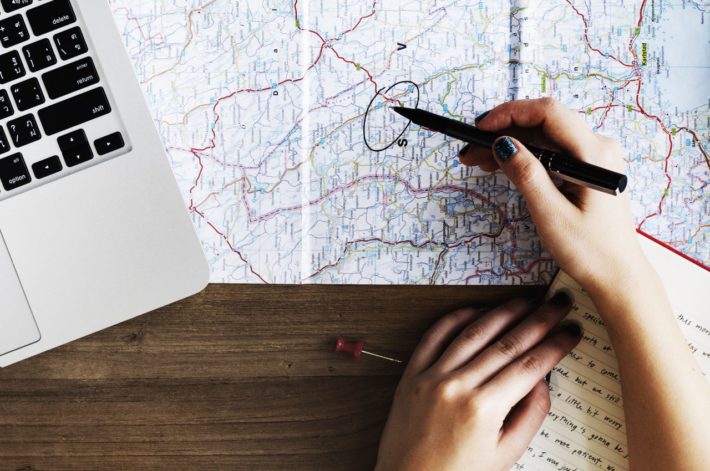Practicing creative writing is valuable time invested in yourself. But sometimes I find it hard to figure out what to write about. Or the blank page seems too daunting and I avoid the practice.
The free online course Creative Writing Sample Lesson both solves the blank page issue, and provides a structured set of exercises to get the creative energy flowing.
The course includes 37 minutes of lecture videos, sample material to download, and multiple exercises to work through. The course focuses on three key story elements: Plot, Character, and Setting.
Maps – Location, Location, Location
Maps and locations are useful tools to augment a story. Think about the importance of Hogwarts school to the Harry Potter series, for example. Maps also help the writer think about Setting. Looking at a map, the writer thinks about places on the map; places where characters exist in the world and why they are there.
Characters – The Details Make Them Feel Real
Good characters feel real to the reader. A character’s behavior is authentic and more meaningful when the character feels like a real person.
Characters are made more real when the writer pays attention to details. The course goes into a series of lectures and exercises about Character Development.
Character Development – a 3-Step Process
Traits give characters depth and personality. The course provides a set of eight sample characters. Each character card includes a list of traits to get you started.
In addition to traits, characters also have things like:
- An occupation
- A home and workplace
- Hobbies
- Key items/objects they value
- Opinions (political, social, cultural)
The three steps are laid out as exercises through the lectures:
- Add two traits to Aster Lee (one of the sample characters).
- Where does Aster work, visit, hang out? Mark those locations on the map.
- Pretend you are Aster. Write a paragraph introducing yourself to a group of people.
Complete these three steps for each character in the sample set. This gives you a group of well-developed characters for your story. Remember that you will not use every single character aspect or trait, but these details flesh out the character in your mind, building up your world and making it more believable.
Events and Plot – Action Moves the Story
The main events, presented in a sequence, comprise the plot of your story. Any one event occurs in that plot, but one event does not make a complete plot. A plot requires multiple events to keep the story moving along and interesting to the reader.
Plotting an event means to break the event into separate Actions, which help construct scenes.
One way to develop the sequence of events is to build a Plot Skeleton. This series of bullet list items lays out the sequence of Actions in the story in order. This is also known as an Outline.
The exercises in this part of the course start with fleshing out a given event from the sample events. Then you are asked to come up with your own subsequent event and break it down into three Actions. Finally, you choose another event from the sample set and repeat the process.
Bring It All Together With Setting
The map gives you locations where you place characters and events. Now use this setting to connect these story elements together, thereby strengthening the story. In the book Impro: Improvisation and the Theatre, Keith Johnstone describes this as “linking” elements together.
You have three exercises in this section:
- Pick a location on the map and two characters who visit it
- Pick an event you developed earlier and place that on the map
- Combine your other characters and plot events with the town in the same way
Develop a Story From What You Created
Your final assignment in this course is to take what you have created and write a story (e.g. short story, news report). It should be at least 1000 words.
To get started, set the initial action. This is the event that motivates your protagonist to do something. If you get stuck along the way, change the scenery. Move to a new location, where you have a new place, new characters and events to keep your writing going.
Remember, your main character should have a goal. When you finish with an event, ask yourself questions like:
- Where do they need to go to get new information?
- Who do they need to interact with?
- What actions do they think are necessary to accomplish the goal?
The goal helps motivate action and acts as your North Star, so you keep the story moving in the right direction.
Conclusion
You can easily extract value from this free course, Creative Writing Sample Lesson. Watch the lectures and review the downloadable samples to learn the skill in under an hour. Or follow through with some or all of the exercises to get practice on your creative writing.
I recommend enrolling in this course for a few reasons. The price is $0. It introduces a process for building your story worlds. The exercises reinforce the learning. And the course includes a self-evaluation, so you can reflect and see how you did. This last piece is an exercise in journaling, and journaling is useful on many levels.
Don’t forget to download my Course Guide below to get an overview of the material and my notes!



